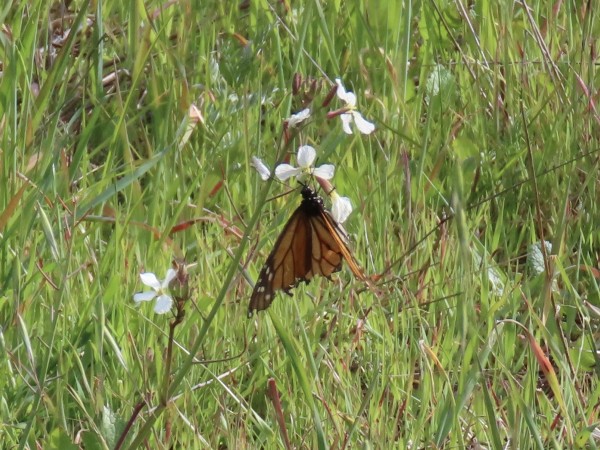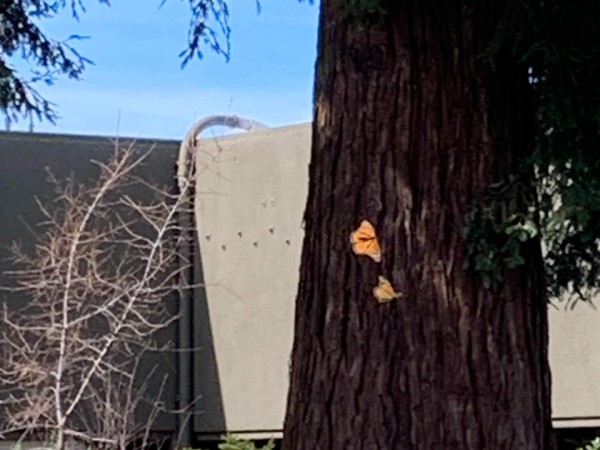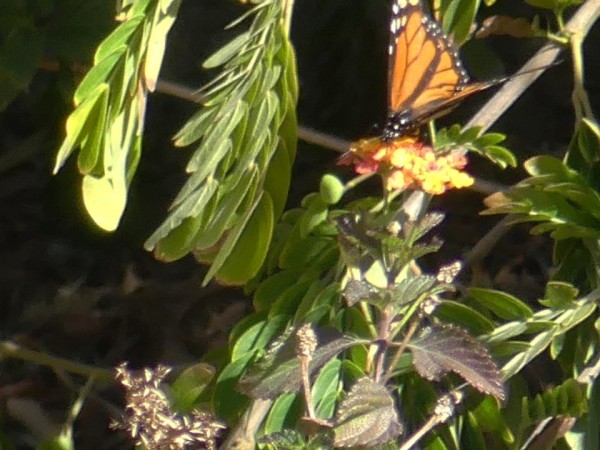Letter From Gail Morris Western Monarch Spring 2023 Report #3
Western Monarchs Update
Storms battered the California coast this past week and temperatures plunged. Monarchs are actively breeding on sunny days and many are still basking in the safety of groves along the California coast rather than leaving the region. Where are the monarchs? Monarchs were reported along the coast from Oakland to Oceanside and also in the Palm Springs area. There was one reported in Las Vegas recently. Be sure to see where they are and help fill our maps with monarch sightings and where milkweed is up!
News from the California Overwintering Sites
We are continuing to monitor monarch movement at a few of the overwintering sites in the West.
Pismo Monarch Grove
Marylou Barker Gooden noted, “The grove has been closed for most of the week because of high winds or storms so I have not been able to check the conditions or the monarchs.” So far, a total of eight trees have been lost this season in or near the grove. State Park staff are planning to plant replacement trees as soon as the season ends.
Pacific Grove
Stephanie Turcotte reports from the Monarch Sanctuary in Pacific Grove:
“Brrrr….is being felt all over the country but especially in California at low elevations where we are unaccustomed to it. It was 36 degrees in the Pacific Grove winter habitat this morning when we counted the monarchs. I observed snow on the top of the Sierra foothills when I made a trip down to Morro Bay the last two days. President’s Day weekend we had much warmer temperatures, sun, and plenty of monarch coupling observed. That was only a week ago. When I checked the interior on 2/21/23, shortly before we got hit with more rain and these frigid temps, I found considerably fewer monarchs inside the PG grove. I worried that many had left because I could only see about 2-3,000 rough estimates AND I searched.
“And again the monarchs surprise, because this morning there were far more than that day I looked 2/21, and now instead of only clustering in 3 Cypress trees (as they were last week), they are spread between 7 Cypress trees, mostly in the interior in the northern end, but also still in the Cypress on the east side, facing east. Although the clusters were pretty high up, there was no activity due to it being SO cold. Even when two squirrels ran across a branch heavily clustered with monarchs, the monarchs remained immobile. And as if the monarchs "came back”, we counted 4,940 monarchs! That’s relatively on par with what we counted last year on 2/25/22 which was 3,858.
“We should be able to get another count in next week. Last year our last count was 3/11.”
Lighthouse Field, Santa Cruz
Diana Magor shares her report on the monarch status in the Santa Cruz area.
Diana visited Lighthouse Field on Saturday at 2 p.m. and found the temperatures cold for monarchs around 55°, but sunny with a light breeze. She counted, “150 monarchs clustered inside the grove on Monterey Cypress. 20 flying on the SE side. All the others were sunning on the south-facing Cypresses. Virtually all I could see clearly were males. I observed 1 lone female sunning and 1 mating. There may have been a few more females inside the grove and one I wasn’t sure of, but well over 90% were males. Interestingly, the proportion of females at Pacific Grove seems to be considerably higher. The only nectaring I observed was one tattered male on a non-native Raphanus (wild radish) plant, of which there were many flowering in the field adjacent to the monarch grove.”
Turbulent Weather
The past week brought extreme weather conditions to California. High winds and relentless rains in some areas brought over five inches of precipitation. Snow dusted sites near sea level, and deeper snow measured in feet blanketed the surrounding mountains. It is not over yet with more unsettled weather forecasted this week. Hampered by temperatures far below normal, most monarchs are exhibiting little movement, even on the few sunny days sprinkled in between storms. Everyone will be watching the effect of these winter storms on the summer population. (See photos by Journey North observers in California.)
Thank You!
A special Thank You to Marylou Barker Gooden, Stephanie Turcotte, and Diana Magor for their reports and photos.
Send in your reports!
Please report your sightings of emerging milkweeds and monarchs in any life stage! Report to Journey North—Provide as much information as you can such as weather conditions (it’s okay to estimate). Your detailed description of what you see can include, but is not limited to, the monarch’s gender and activity and, if known, the type of milkweed, and flowers if they are nectaring. Let us know how monarchs are faring under stressors from winter storms still sweeping through!
Gail Morris is the Coordinator of the Southwest Monarch Study (www.swmonarchs.org), a Monarch Watch Conservation Specialist, and the Vice President of the Monarch Butterfly Fund, the Central Arizona Butterfly Association, and the Western Monarch Advocates. The Western Monarch Population News is based on comments provided to Gail Morris. We hope to increase the number of sightings and therefore photos and comments entered into the Journey North. We rely on the volunteers who communicate regularly with Gail and who agree to participate in our effort to increase awareness of the population of western Monarchs. You can reach her at gail@swmonarchs.org
[original submitted, 02/27/2023; published, 02/28/2023]




